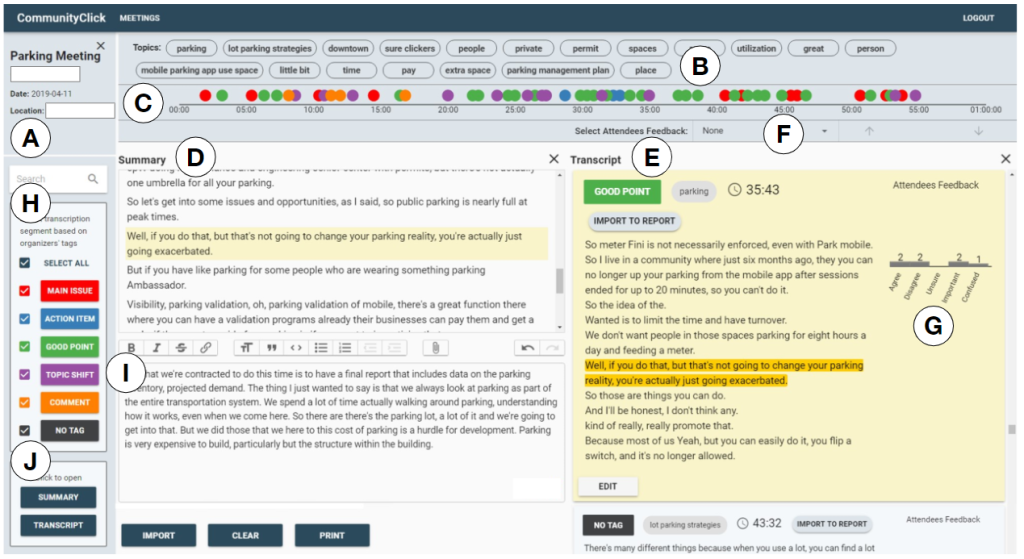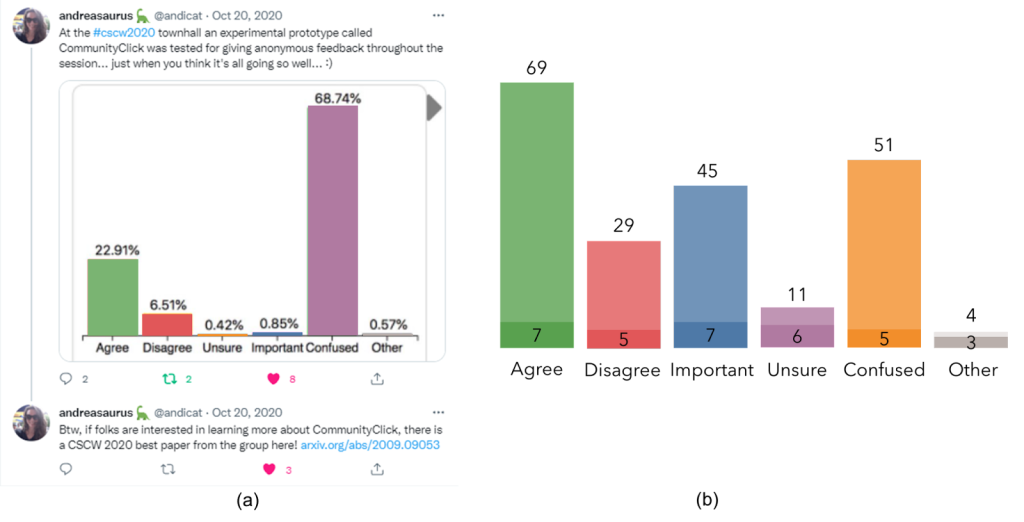CommunityClick-Virtual: Supporting Inclusive Participation during Online Public Engagement Events
By
CommunityClick-Virtual: Supporting Inclusive Participation during Online Public Engagement Events
Public engagement is paramount for participatory democracy. For decades, traditional methods, such as town halls, public forums, and workshops have remained the modus operandi for public engagement. The goal of these engagements is to ensure inclusivity of public participation so that decision-makers can engage, exchange thoughts, and make informed decisions based on public-generated data and feedback on critical civic issues.
However, traditional methods are often limited in providing opportunities for inclusive public participation. Despite showing up in public engagement events, reticent attendees often struggle to speak up and articulate their viewpoints due to several barriers such as fear of confronting outspoken and dominant individuals, language barriers, and lack of argumentation skills [1]. As such, the discussion and thought exchange between decision-makers and the public often inadvertently skew towards the output received from individuals who are comfortable with speaking up and who possess expertise in analytical and rhetorical reasoning to hold public conversations. As a result, traditional methods of public engagement results in an uneven representation of public opinions and often fall short to capture broader perspectives from attendees.
Recent advancements in computer-mediated technology and digital civics have created new opportunities to address this issue by introducing novel communication channels between decision-makers and the public. Digital civics is an emerging cross-disciplinary area of research that explores new and improved ways to utilize technology for promoting democratic participation in the design and delivery of civic services. The overarching goal is to enable wider participation by utilizing technology to support participatory democracy and greater transparency [2, 3, 4]. For instance, researchers investigated new input modalities to receive audience responses in the form of voting and poling, alongside verbal participation during public engagement events.
In 2020, we designed and developed CommunityClick [5] where we used modified iClickers to enable reticent meeting attendees to provide their feedback during town halls anonymously in real-time. We deployed CommunityClick in a town hall meeting in Amherst. Our evaluations indicated that CommunityClick can create an equitable platform to share more inclusive feedback in town halls and the organizers found it effective for authoring credible and accurate reports that capture attendees’ perspectives more inclusively. This work was published at The 23rd ACM Conference on Computer-Supported Cooperative Work And Social Computing in 2020 and received the best paper award. Here is the link to the conference talk.

The Shift in Public Engagement Practice due to the COVID-19 Pandemic
Public engagement practices were severely disrupted by the COVID-19 pandemic that brought all traditional public engagement to a standstill. Due to mandatory lockdown and other health precautions, the world saw a sudden shift in the way public engagement takes place. Many local and global governments moved to online teleconference applications such as zoom and social media for public engagement. While this shift allowed for broader engagement over digital technology, it raised new questions and challenges regarding inclusive participation. For instance, the webinar and forum-style Q&A sessions during public engagement events often do not promote inclusive participation as the attendees get a very limited amount of time to share their opinions. Furthermore, oftentimes attendees are required to identify themselves before sharing their feedback which might discourage some attendees from speaking up and risk confrontation.
CommunityClick-Virtual
To address this issue, we developed a virtual version of CommunityClick, called CommunityClick-Virtual [6], which is a companion web application that allows attendees from all walks of life to anonymously share their opinions in real-time during public zoom meetings. We have been working in close collaboration with the Town of Amherst since June 2021 to refine existing CommunityClick features and co-design new ones. For instance, we added a chat option for attendees where they can elaborate on their feedback and justify what they think using free-form text messages. We added profanity and spamming detection in the chat to keep the conversation civil. Furthermore, the meeting organizers can modify the chat settings to be public, private, or disabled in real-time based on the nature of the meetings and their audiences. They can also moderate messages and flag them if they found the message includes inappropriate language or themes including personal attacks, offensive language, and disruptive elements.
How Attendees Use the System
The attendees start using CommunityClick-Virtual by first providing some non-identifiable demographic information, such as their general location and optional age, racial identity, preferred language, and housing situation to help the town understand their reactions and feedback better. At any point during the meeting, attendees can provide feedback by using a collection of customizable reaction options, such as, Agree, Disagree, Important, Confused, and Unsure. Attendees can also use a live chat option to provide detailed feedback or share opinions on the meeting agendas, topics, and discussions. They also have access to a real-time visualization of collective reactions that enables attendees’ to gauge how the discussion is progressing and how people feel about the meeting discussions, overall.
CommunityClick-Virtual’s Features for Organizers
The system provides government officials and meeting organizers with an analysis dashboard, which displays several real-time statistics including the number of active attendees, trending reactions, and chat messages. CommunityClick-Virtual also tracks the number of unique attendees corresponding to the reaction received to combat spamming and gamification of the responses. It also provides organizers with a set of visualizations and statistical graphs of reaction distribution alongside the features and functionalities to control the settings. The system provides customizable options for organizers to enable or disable the real-time graph and chat options for the attendees.
CommunityClick-Virtual Deployment at CSCW 2020 Town Hall
We deployed an early version of CommunityClick-Virtual as a pilot study during the town hall of the 23rd ACM Conference on Computer-Supported Cooperative Work and Social Computing (CSCW) in 2020. During the town hall, more than 700 participants joined from across the world to discuss experiences at the CSCW conference and its future directions. While the organizers thought the town hall was successful, from the data collected from CommunityClick-Virtual, they realized that the majority of the attendees were confused, as shown in a tweet shared by one of the town hall organizers (Figure 2(a)).

Deployment in Town of Amherst Public Hearing
A refined version of CommunityClick-Virtual was deployed on December 2nd, 2021 in a Town Services and Outreach Committee public hearing for discussing the parking situation at Kendrick Park [7]. There were 15 attendees in the meeting, all of whom used CommunityClick-Virtual, and 11 of them actively participated by using CommunityClick-Virtual’s features. Among the responses received from these attendees during the 52-minute public hearing, 69 were agree, 29 were disagree, 45 were important, 51 were confused, 11 were unsure, and 4 were others. They also posted 10 text messages using the chat options (Figure 2(b)). The response and engagement patterns during this deployment suggest that attendees were enthusiastic to participate and share their opinions.
The Future of CommunityClick-Virtual
The government officials and decision-makers want to engage and learn from the public, especially on issues that might heavily impact disenfranchised or disadvantaged communities who might not be able to attend the full duration of the meeting and wait for their turn to provide feedback. Systems like CommunityClick-Virtual can provide them with an opportunity to provide an option for these communities to contribute equally to other attendees. In the future, we plan to continue our close collaboration with the Town of Amherst to design and develop further technologies including analysis components that will help decision-makers track opinions, weigh in feedback, and make data-driven decisions that take into account the perspectives of people from different demographics for more inclusive participation and build trust among decision-makers and the public. We are already scheduled to deploy CommunityClick-Virtual in the upcoming public outreach meetings for the Jones Library starting June 2022.
We strive to propel tools like CommunityClick-Virtual to shape the future of work adapting to remote operations. For instance, CommunityClick-Virtual could be integrated into the online classroom in the education domain or enhance administrative group meetings in the industry.
References:
[1] Tracy, Karen, and Margaret Durfy. “Speaking out in public: Citizen participation in contentious school board meetings.” Discourse & Communication 1.2 (2007): 223-249.
[2] Mahyar, Narges, et al. “The civic data deluge: Understanding the challenges of analyzing large-scale community input.” Proceedings of 2019 on Designing Interactive Systems Conference. 2019.
[3] Vlachokyriakos, Vasillis, et al. “Digital civics: Citizen empowerment with and through technology.” Proceedings of the 2016 CHI conference extended abstracts on human factors in computing systems. 2016.
[4] Olivier, Patrick, and Peter Wright. “Digital civics: Taking a local turn.” Interactions 22.4 (2015): 61-63.
[5] Jasim, Mahmood, et al. “CommunityClick: Capturing and reporting community feedback from town halls to improve inclusivity.” Proceedings of the ACM on Human-Computer Interaction 4.CSCW3 (2021): 1-32.
[6] CommunityClick-Virtual, https://communityx-59d5e.web.app/, June 2022.
[7] Town to Test New Public Participation Tools, https://www.amherstma.gov/CivicAlerts.aspx?AID=3018&ARC=5916, December 2021.
